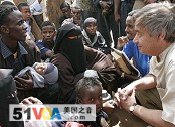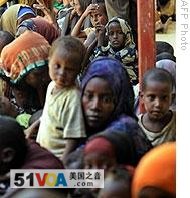Nairobi
18 May 2009
The international medical organization Doctors Without Borders is warning that conditions at the main camp for Somali refugees in Kenya have gotten so bad that many refugees are contemplating returning to Somalia, even as renewed fighting there causes a fresh wave of displacement.
 |
| UN High Commissioner for Refugees Antonio Guterres talking to newly arrived Somali refugees at Kenya's sprawling Dadaab refugee camp in 2008 (file photo) |
Refugees have been crossing the border from Somalia to Kenya since civil war broke out in 1991. But Doctors Without Borders head of mission in Kenya, Joke Van Peteghem, says the three camps, which were built to hold 30,000 people each, have far exceeded their capacity.
"Where initially 90,000 people were settled in these camps now we are talking of 270,000 people. Water is very scarce. There is not enough space to accommodate all the people. At the moment if you arrive in Dadaab as a new refugee, you are registered and after you receive some nonfood items, you are told to find your own way," Van Peteghem said.
According to the U.N. refugee agency, Dadaab is the largest refugee camp in the world. As many as 10,000 people arrive every month.
With Somalia experiencing its heaviest fighting in months, as well as its worst drought in the past decade, the flow of refugees is expected to continue. UNHCR has requested additional funds to supplement its annual budget.
Following a survey it conducted at Dadaab's Dagahaley camp, Doctors Without Borders found that nearly a quarter of the population faced "acute malnutrition." Other agencies have warned that the supply of water is threatened by the camps' aging infrastructure, which could lead to outbreaks of cholera and other disease.
 |
| Newly arrived Somali refugees at a registration center at the Dadaab camp, northeastern Kenya (file photo) |
While refugees continue to arrive, few are resettled. Less than 10,000 are expected be moved to new countries this year and the continuing conflict in Somalia has prevented refugees from returning home.
Van Peteghem says that some refugees have been driven to consider returning to Somalia by the poor conditions in the camps.
"So adding all these issues up, for some people, they feel that they would rather go back home even if the situation there security-wise is not improving, on the contrary, than staying in these refugee camps where basic services are just not provided," Van Peteghem said.
Kenya's border has been officially closed since the latest round of Somalia's conflict began in early 2007. According to aid agencies, this has not slowed the pace of new arrivals, but it has meant that new refugees are not registered properly, and do not receive medical screenings.
Doctors Without Borders is calling for additional support from international donors and for the Kenyan government to move ahead with plans to build a new camp. A new site has been identified, but progress has been slow.
There has been growing tension and competition for resources between the local Kenyan community and residents of the camps. A new camp is eventually expected to hold about 120,000 refugees, but no more than 30,000 are expected to be there by the end of the year.
In addition to the refugees who have crossed the border, UNHCR says there are 1.3 million people displaced from their homes within Somalia. In the past 10 days, 42,000 people have fled their homes in Mogadishu, according to the agency.